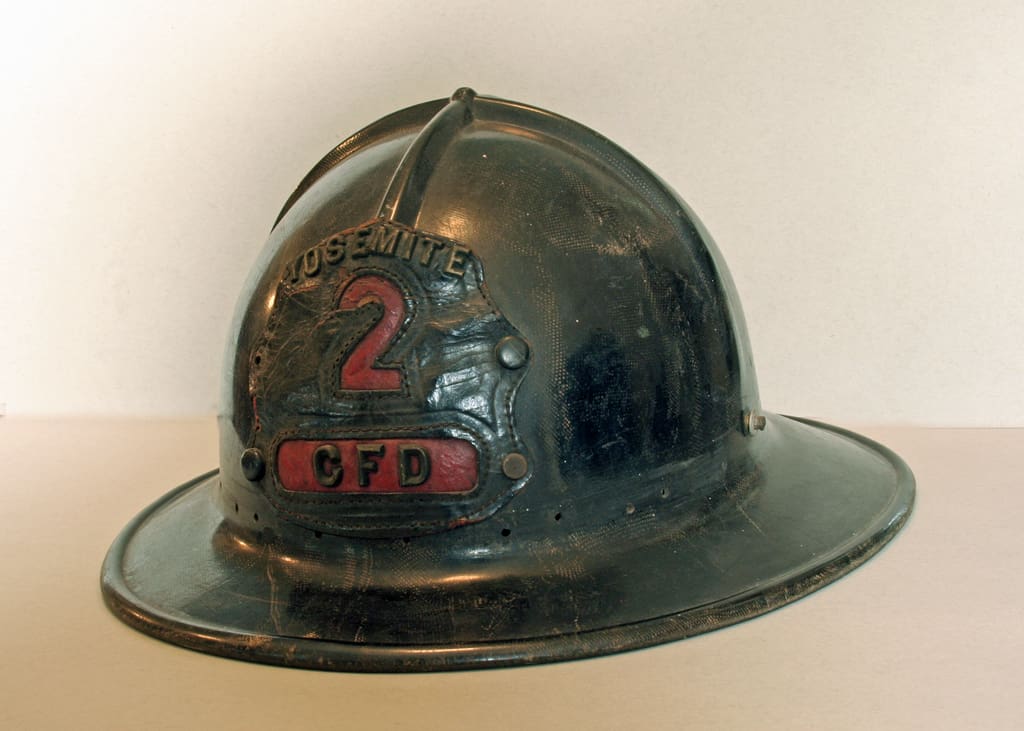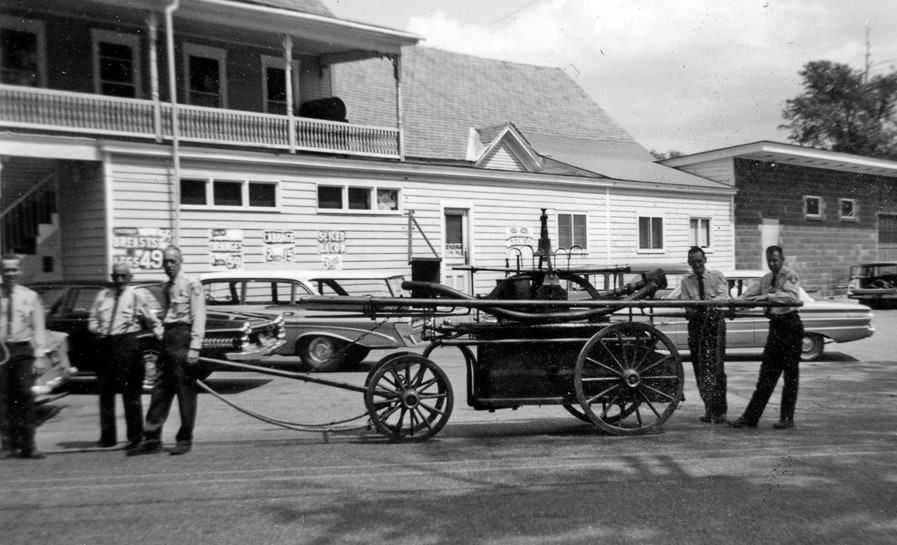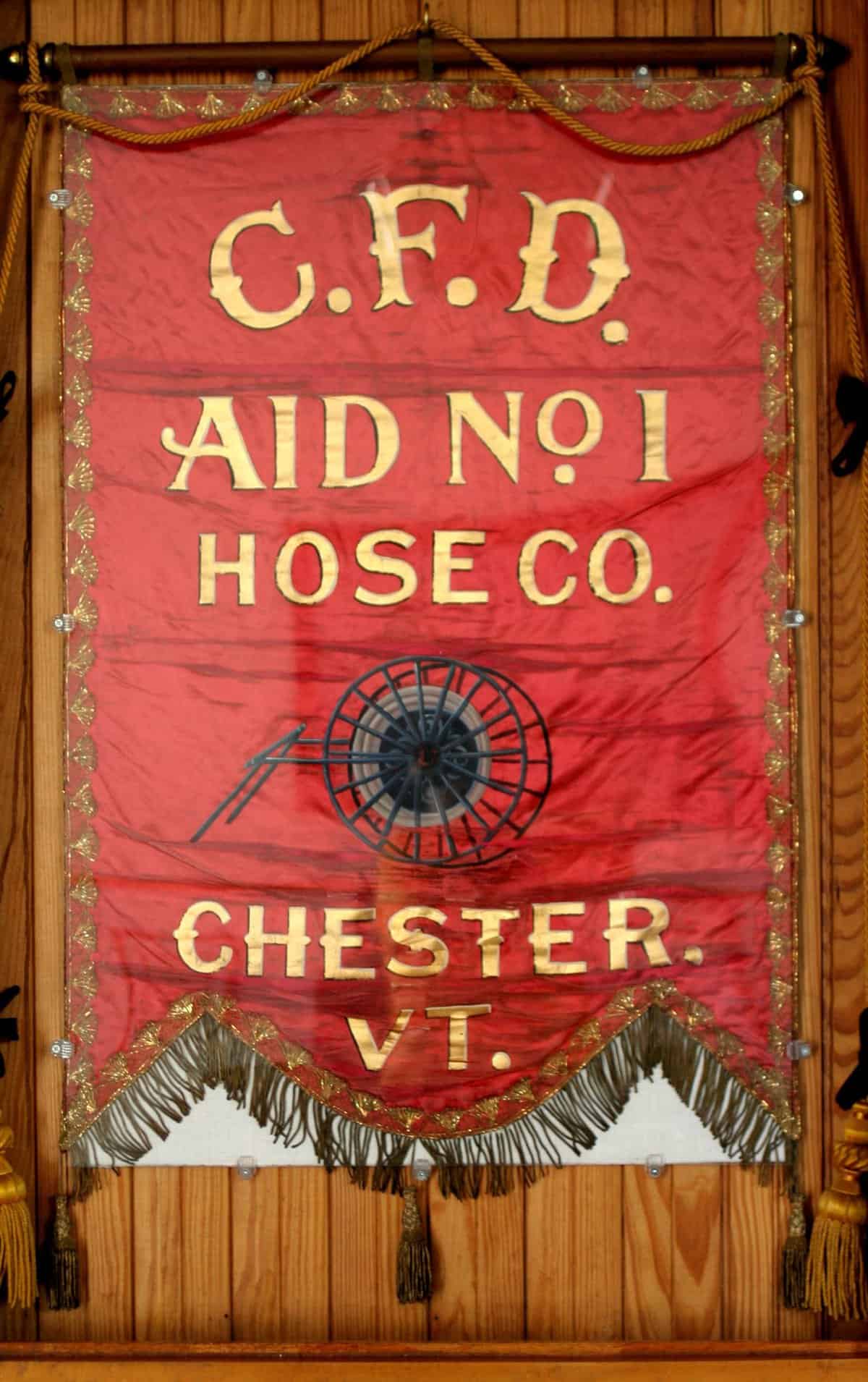
By Donald E. Mitchell (Dictated to his daughter, Donna LeClair, July 2002)
…A man named Wellman lived across from present day Gould’s Market and left of the library. He was an early photographer in Chester and his home caught fire. The time period was probably late 1940s.
I had the truck parked on the corner of School and Main Streets at the south end of the Green. Clyde Clark, a plumber by trade, who lived on Elm Street in the Depot, was working a portable pump, feeding the water out of the Williams River (at the footbridge) to my truck.
We had a two to two-and-a-half-inch discharge hose line running from the truck down to the Wellman house. When the nozzle was shut off to the hose line, I had to open the gate valve to spill the water that was being fed to the truck I was operating, and I put the water right up onto the porch of the house that is on the corner of School Street and Main Street (the present day Finn and Stone building). You didn’t want to stand in front of the gate valve when you opened it. Today this 1931 American LaFrance Rotary Gear Pump still belongs to the Fire Company, and is used for parades.
During this time period, there were two fire districts in the Town of Chester. This created a fire department for each district. The town did not have a fire department in the early years. A group of property owners interested in starting one petitioned the legislature to have a fire district. This would allow the district to raise taxes, to operate a fire department, to buy equipment, and to pay for street lighting and garbage collection if the legal residents of the fire district so desired.
I don’t know how many years this went on, but it didn’t work out to the satisfaction of some of the people in the Depot area, because they wanted to spend some money and get some equipment, whereas the people in the village were holding back from the Depot residents being able to do this.

The legislature was petitioned again to form a second fire district, which would cover a square mile of area in the Depot section (this section began at the top of Depot Hill, at the former Mackey’s Auto Body [present day Chester Auto Body] and First Avenue).
There was a fire hydrant right across the road from there, which we called the “Half-hydrant,” because the village paid half the cost of water and the Second Fire District paid the other half. The second Fire District took care of all fires within the township of Chester and billed the town at the end of the year for all services rendered, and the rest of the fires were covered by the Yosemite Engine Company.
At that time there was a little resentment between the two districts. The village didn’t want their equipment outside of their fire district. They would answer any fire calls within our district but not in the outlying township.
In fact, in other parts of the country, fire departments and companies had their own territories, and it was not unusual for some to go only as far as their own boundary and not cross the invisible line into another area, even if the fire were just across the line in another district.
The two companies have now banded together into one department and are under the control of the Town of Chester. The principal reason this came about was because of the federal government’s practice of giving money away for town improvements. This involved a lot of paperwork that the district could not handle because we were all volunteers, and it would take someone who was a “Philadelphia Lawyer” to complete the paperwork to acquire the money. There was also a problem of keeping enough men together to keep the district going.
In the early days of the two districts, the Yosemite Engine Company tried to keep twenty active volunteers in the department. Sometimes it would be a little over that and sometimes a little under. Between the federal paperwork and the need to band together to have enough men, the town got a new truck immediately.

The town might have to contribute something to it – it may have been a 90-10% split with 90% being on the part of the federal government and the 10% on the part of Chester. The cost of the truck was fairly reasonable to Chester, if we had to pay anything at all. (There is some question regarding whether we did.)
Back before my time, when the Yosemite Engine Company had the old hand pumper, there were wells at different points around the Depot that were dug and covered. In the event of a fire, a suction hose was put into them to get water for the hand pumper. There was a well on First Avenue; there was one on Elm Street (somewhere across the road from the house Clyde Clark lived in, but a little nearer to the Depot); there was one (I think) in front of Earl Horton’s house on the front lawn near the sidewalk. If there were others, I am not aware of them, but I was aware of those. We never used any of them in my time. Probably now, they all have been filled in and passed over. (The former Clark home is to the right of the present day Excel Janitorial, and Earl Horton’s house is the big two-story home across the street from present day Lisai’s Market.)
NOTE: Donald Mitchell lived on Green Mountain Turnpike, second house on the left, now owned by his grandson, Mark Mitchell.
Mitchell’s Maples began as a very small sugarhouse built by Don to provide sugar and syrup for his family during WWII when sugar was rationed.
This week’s old saying: “Those who can, can. Those who can’t, teach.”